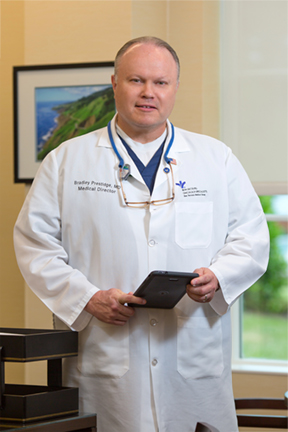Regional Medical Director
for Radiation Oncology
Bon Secours Cancer Institute at DePaul
 In November of 2012, when Bon Secours Virginia broke ground on the Bon Secours DePaul Medical Plaza, it was with the vision of establishing a comprehensive cancer institute, which would place state-of-the-art technology in the hands of cancer experts, enabling them to address the unique needs of patients battling cancer. Less than a year later, Dr. Bradley Prestidge, a world-renowned radiation oncologist, came to DePaul with his own particular vision: a comprehensive suite in which to treat cancer patients with the specialized radiation technique known as brachytherapy.
In November of 2012, when Bon Secours Virginia broke ground on the Bon Secours DePaul Medical Plaza, it was with the vision of establishing a comprehensive cancer institute, which would place state-of-the-art technology in the hands of cancer experts, enabling them to address the unique needs of patients battling cancer. Less than a year later, Dr. Bradley Prestidge, a world-renowned radiation oncologist, came to DePaul with his own particular vision: a comprehensive suite in which to treat cancer patients with the specialized radiation technique known as brachytherapy.
Thus he had a hand in the design of the brachytherapy suite at the DePaul Cancer Institute; a hand so large, in fact, that he says the architects often tried to look the other way when they saw him coming. He’s only half joking, but the result is clear: “Very few centers have the efficiency and the capability we have at DePaul,” Dr. Prestidge says. “We can do many things that can be done in an operating room there. It’s completely shielded behind a three-ton door, so we can administer brachytherapy in the same room after we perform our procedures, without ever having to wake and move the patient. I specifically asked for that before I came here.”
In some centers, he explains, it can take as much as a day to complete a treatment, because the anesthetized patient is taken to one room to have the radiation applicators placed, awakened to get on a gurney and taken for a CT scan so the computer plan can be completed. The patient is then brought back into the original room for treatment. At DePaul, it’s all done in the brachytherapy suite, and treatment be completed in as little as an hour.
Brachytherapy wasn’t new to Hampton Roads when Dr. Prestidge came to DePaul, but he quickly learned that one vital application of the modality wasn’t being offered: high dose rate brachytherapy for patients with non-melanoma skin cancers like squamous cell carcinoma and basal cell carcinoma. In Hampton Roads, with its welcoming climate, beaches and outdoor activities, these cancers are commonly diagnosed. He began reaching out to dermatologists and plastic surgeons to explain the benefits of brachytherapy as an alternative for their more complex cases, which can require extensive surgeries.
“Using an intraoperative 3-D computer plan, we put a single, highly radioactive source, not much larger than a quarter inch, on the end of a cable that goes down a tube into an applicator placed into or on the tumor,” Dr. Prestidge explains. “The applicators are specifically shaped, molded to the area of the cancer – often the ear or the nose.” That single, highly radioactive pellet comes down through a catheter into the applicator, either inside or on the surface of the skin, and sits there for a number of seconds while the computer moves it to different positions inside the applicator to deliver the dose. When the dose is delivered, the source is retracted into the shielded after-loader, and the treatment is done. Patients leave with no radiation in their body.
It’s a highly effective therapy, Dr. Prestidge says, which he also employs for breast, prostate, cervical, esophageal and rectal cancer cases. And he emphasizes, “The Cancer Institute is very comprehensive in terms of all its radiation modalities. I think we’re on par with most any academic radiation department in a university center. We also do external beam, stereotactic radiosurgery, stereotactic body radiation. And we just opened the infusion center in September.”
Many cancer patients in Hampton Roads have historically felt the need to travel to Duke or Johns Hopkins, but we have world class cancer care available here.

